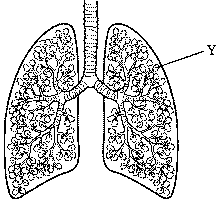8B Quick Quiz
8Ba
1 What is digested food used for in our bodies?
A To provide energy only.
B To provide energy, for growth and to provide chemicals to make new substances.
C To provide oxygen.
D To provide carbon dioxide.
2 What is the name of the process that releases energy in our bodies?
A photosynthesis
B excretion
C reproduction
D respiration
3 What substance is used as the main energy resource in our bodies?
A protein B glucose
C oxygen D water
4 In what ways is burning similar to respiration?
A Both reactions produce oxygen and water.
B Both reactions use oxygen and water.
C Both reactions occur in one uncontrolled step.
D Both reactions release energy and produce carbon dioxide.
8Bb
1 How is oxygen transported around the body?
A carried on red blood cells
B as a gas
C carried on white blood cells
D attached to glucose
2 The heart and blood vessels make up the:
A breathing system. B digestive system.
C nervous system. D circulatory system.
3 The heart has two halves. This is because:
A one half pumps blood to the lungs, and the other half pumps blood around the rest of the body.
B one half is not used except in an emergency.
C one half pumps blood around the body one way, and the other half pumps blood around the body in the other direction.
D one half pumps blood, and the other half pumps water carrying dissolved food.
4 The smallest blood vessels are called:
A veins. B arteries.
C capillaries. D tributaries.
8Bc
1 When you exercise:
A your pulse rate stays the same, but your breathing rate goes up.
B your pulse rate goes up, but your breathing rate goes down.
C your pulse rate goes down, but your breathing rate goes up.
D your pulse rate goes up, and your breathing rate goes up.
2 How is carbon dioxide transported around the body?
A carried on red blood cells
B as a gas
C carried on white blood cells
D dissolved in the plasma
3 The word equation for aerobic respiration is:
A glucose + carbon dioxide ® water + oxygen (+ energy)
B glucose + oxygen ® water + carbon dioxide (+ energy)
C oxygen + carbon dioxide ® water + glucose (+ energy)
D oxygen + water ® glucose + dioxide (+ energy)
4 Cells that need oxygen take it from a liquid that leaks out of capillaries. This liquid is called:
A oxygenated blood.
B lymph.
C tissue fluid.
D formalin.
8Bd
1 Air entering the lungs would pass through the following structures in the order:
A trachea ® bronchus ® air sac ® alveoli
B trachea ® bronchus ® alveoli ® air sac
C alveoli ® trachea ® bronchus ® air sac
D bronchus ® trachea ® air sac ® alveoli
2 What part of the lung is labelled Y, in the diagram?

A diaphragm B windpipe
C air sac D bronchus
3 The movement of particles from an area where they are in a high concentration to an area where they are in a lower concentration is called:
A dissolving. B transport.
C diffusion. D excretion.
4 Mucus lines the air passages and traps dirt and tiny organisms called microbes. It is moved up and out of the lungs by tiny hairs called:
A villi. B cilia.
C bristles. D filaments.
8Be
1 The air we breathe in contains:
A more oxygen and more water vapour than the air we breathe out.
B more oxygen and less carbon dioxide than the air we breathe out.
C more carbon dioxide and less oxygen than the air we breathe out.
D more carbon dioxide and less water vapour than the air we breathe out.
2 Water vapour can be detected using:
A limewater.
B hydrogencarbonate indicator.
C cobalt chloride paper.
D universal indicator paper.
3 Limewater is used to test for:
A oxygen.
B nitrogen.
C hydrogen.
D carbon dioxide.
4 Hydrogencarbonate indicator is yellow in acidic solutions, purple in alkaline solutions and pink in neutral solutions.
If exhaled air is bubbled through hydrogencarbonate indicator solution, it would turn the indicator:
A purple.
B yellow.
C pink.
D cloudy.